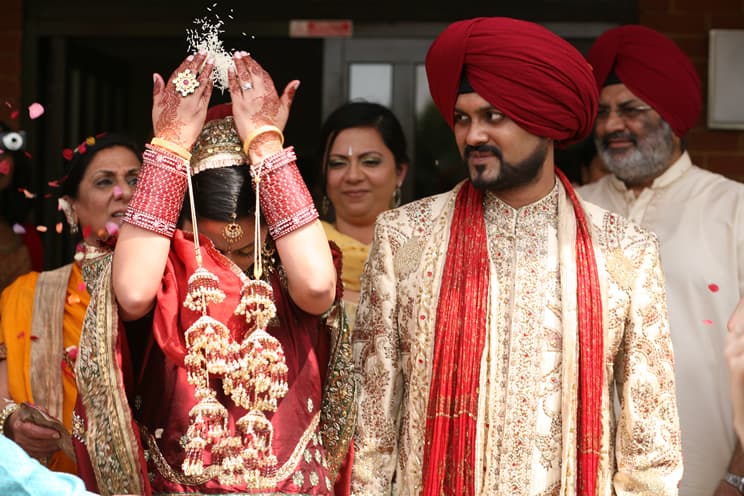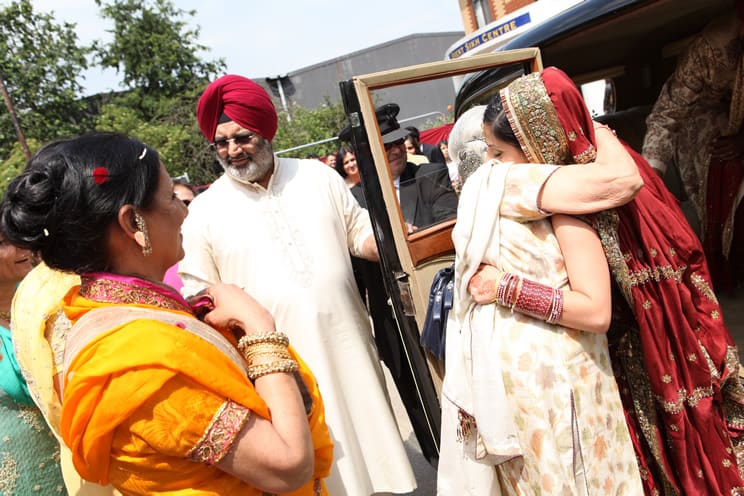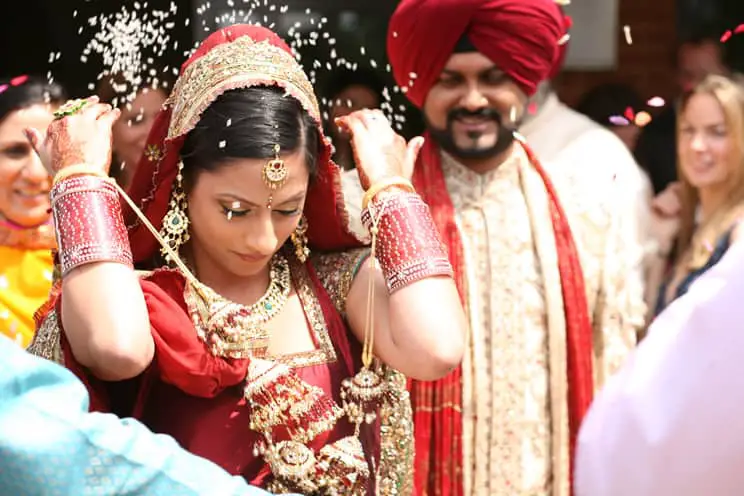
I always thought that all Sikh marriage traditions ended with the wedding ceremony and reception. Little did I know that one more important ritual was performed as a bridal send-off – the doli ceremony. So I inquired around and did some digging to understand what doli is all about.
So what exactly is doli at a Sikh wedding? Doli is a ceremonial send-off by the bride’s family. It is when the bride bids her family and friends goodbye and is escorted to her doli (a carriage or cot that will take her to her matrimonial home) by her father and all male family members. These men will carry the bride ceremoniously to her new home.
Doli still remains symbolic of Sikh wedding traditions. It is a beautiful way for the bride to make a grand entrance to her husband’s home.
History of the Doli Ritual
The doli originated in Bengal. During that time, royal ladies weren’t allowed to be seen in public, so they traveled in palkis. When Bengal was colonized by the British, all the British ladies used palki to show off their status. Thus the doli was seen as a symbol of wealth.
Since then, the doli ceremony is performed to give the bride a royal experience when leaving their paternal home to join her husband’s family. Every Indian believes that their girl should be given to someone special. That’s why they adorn her in elegant bridal wear and jewelry to complement her stature.
The doli is spectacularly adorned for the girl, so she’ll be carried by uniformed men to her matrimonial home. Sikh dolis come in elegant designs to make the vidai ceremony the grandest finale the bride deserves.
The Meaning and Significance of the Doli Ceremony
The doli ritual is the final phase of the Sikh wedding. This is when the bride’s parents and relatives bid their farewells to the new couple as they start their married life. Doli is often emotional, considering the goodbyes that will be exchanged during the ceremony.

The special significance of this ritual is the mixed emotions of joy and sorrow exhibited by the participants. The parents are happy that their little girl is starting a new, blissful life, and they’ll bless her and her married life with celebration.
But at the same time, sorrowful emotions fill the air as the pain of parents separating from their daughter becomes real. The bride is also sad and teary when she hugs her parents and receives blessings from all the elderly relatives by touching their feet.
What Happens During the Doli Ceremony?
Doli is a bittersweet moment, especially for the bride and her family. It is the most sentimental stage of the wedding. The thought of parents-daughter separation for a lifetime causes teary eyes in both parties.
The doli occasion sums up all the previous ceremonies. When reality sets in, everyone loses control. Traditionally, doli marks the bride’s transition from a loving daughter to a caring, responsible, and loving wife.
After the wedding reception, the couple’s friends and relatives and the groom will converge to the bride’s home for the doli. The groom’s mother will go back to her house to prepare for the couple’s arrival.
To perform the doli ceremony, the bride will wear the clothes and jewelry given to her by her in-laws. She’ll then be required to feed cooked rice to all males in her family.
The bridegroom and his family will head to the bride’s home for the doli ceremony. They’ll be received at the front door by the sisters and female relatives of the bride. They will not let the groom and his family into the home without meeting their financial demands.
The groom will have to pay his way into the bride’s home. Once he pays up, the family will be allowed inside and offered refreshments.
Sometimes it’s fun to see how the groom and his entourage are blocked at the front door by the bride’s female relatives and dared to enter.
At the bride’s house, the couple will be made to sit together in the living room to receive gifts from the bride’s parents. Usually, they’ll be gifted with money, a watch, and other forms of gifts then served with auspicious Laddoos.
When it’s time to leave for their marital home, the bride and groom will stand up and together, walk towards the door. While walking, a bowl of puffed rice will be held before the bride. She’ll then scoop a handful to throw it over her head to every corner of the house. This gesture symbolizes the bride’s declaration of leaving her paternal home to start a new life from scratch. It also conveys her best wishes for long life and prosperity for her parents.
As she heads towards the door, the bride’s female relatives who are married will pour oil at the doorstep as a rite of fertility.
As they walk towards the wedding car led by her brothers or male cousins, all the bride’s relatives will take turns to bid her farewell and wish her luck as she begins a new chapter of married life. They’ll then throw rose petals and other flowers to the newlyweds as they enter the car.
Traditionally, the bride is carried in a palanquin or doli by all the male family members, including her brothers. The procession will continue from her village to the marital home. The husband will lead the procession on a horse carrying a Kirpan (sword). The sword is part of the wedding attire. Today, Sikh brides depart from their homes in a car.
The relatives of the bride and guests will throw coins ahead of the carriage as it starts moving. The tradition of throwing coins at the procession is to wish the bride a happy and prosperous married life.
Another custom performed during doli is when the bride uses the kaleeras on her wrists to tap one of her unmarried female relatives, so she’ll be the next one to get married.
The Significance of Throwing Rice Over the Shoulder
When a daughter leaves her home to get married, she throws rice to her house to reassure her parents and pray for their prosperity.
The tradition of rice throwing means that the bride is symbolically thanking her parents for raising her up until this day when she’s going to start her own family.

So as she begins a new life, she has to ward off any evil by throwing the puffed rice.
Rice is an Indian staple food that transcends cultures; that’s why it’s often an intrinsic part of every wedding. To many, rice is a symbol of fertility, auspiciousness, and prosperity. It has become an essential part of the Sikh marriage tradition.
In the west, parents shower newlyweds with rice to bless them with fortune, fertility, and prosperity.
After the Doli Ritual & Arrival of the Bride at Her Husband’s House
When the bride and groom arrive at her husband’s residence, they’ll be met and warmly greeted by the groom’s family, who’ve been waiting inside.
The groom’s mother will pour oil on the doorstep before the couple is allowed to enter the house. This ritual is performed to remove any evil that may be cast on the couple and also to symbolize the happiness that has filled the house.
On entering the house, the couple will bow down to touch the feet of all the elders present. This is a way to seek marriage blessings.
An aarti prayer will be performed before the bride is showered with flowers and given sweets to eat. Lamps will be lit in the house too.
The groom’s mother will attempt to drink a mixture of water and milk from a lota but will be playfully prevented by her son, the groom. She’ll do this three times before she’s eventually allowed to drink the mixture. This is a way of blessing the couple.
Neighbors and relatives will then come to meet the bride and offer their blessings to her.
The Paani Varna Ritual
It’s because of this ritual that the mother of the groom is absent during the doli. She’ll be at her home preparing to welcome the new couple. She’ll be at the doorstep to bless the couple as they enter the house.
Inside the house, the couple will be taken to the family deity to seek blessings before sharing a glass of milk to strengthen their love. The elders will then give her their blessings and gifts.
The mother-in-law will also get a glass of water, circle it three times around her bahu and offer the bride to drink. Doing this symbolizes her blessing and acceptance of the girl as her new daughter.
The bride will be given Khichadi (rice) and cooked dal to eat. This will signify that she is now a full member of the household. She’ll then offer obeisance to all the senior women relatives, who will then gift her with money.
The groom’s mother will then offer gifts to the bride, including jewelry and clothing, to start her off in her transition to her new life, family, and home. She’ll also undergo religious prayers as she continues to be absorbed into the larger matrimonial family.
Now the newlyweds are ready to turn a new leaf as husband and wife. The transition is completed, and it’s now time to start the beautiful journey of marriage. In bad or good times, they’ll share every moment as man and wife.
The Doli Dinner/Reception
All friends, guests, and family members will stay longer to celebrate and party. As a courtesy, the bride’s family and relatives will be invited to the doli dinner.
The doli dinner celebration can be held differently depending on the number of guests present. It can be a 30-minute or one-hour cocktail party or a fully-fledged celebration that will last all night or continue until the wee hours of the night.
The doli dinner ceremony cannot go without sumptuous food, games, joota chhupai fun, choreographies, dance, singing, making merry. Everyone enjoys mingling, bonding, and creating new friendships.
The hosting parties (groom’s family) will decorate the home with mesmerizing designs that complement the Sikh culture.
As the party continues, the in-laws will ask the guests to sit down as the evening’s formal program begins. They’ll formally introduce the bride’s parents, siblings, and bridesmaid, then the groom’s parents, siblings, and groomsmen.
The newlyweds will then make an entrance and get introduced to the people. They’ll then greet the guests and join the party. The cake cutting ceremony will be held afterward.
Speeches and performances are part of the ceremony. Belly and bhangra dancers will always liven the occasion all through the night. At the end of the party, the hosts will give final speeches to extend their appreciation to friends and family.
The Phera Ritual
The phera occurs one day after the wedding. The couple will first visit the Gurdwara to pay respect as a married couple before heading to the bride’s home.
The bride’s parents will prepare a special meal for the married couple to welcome their lovely daughter and her husband. The couple will have to spend the night and return to their matrimonial home the following day. They’ll be given a lot of presents to take to the in-laws.
The phera ritual is a family reunion where the bride will show her family that she is settled in her new home. It is also a moment when she will get reassurance that her parents and siblings are coping well after her departure.
The bride will visit her parents several times alone. During these visits, her parents will always gift her with ornaments and clothes. The groom will have to fetch the bride from her parents’ home twice before they consummate their marriage.
How Sikhs Perceive the Reception Custom
The custom of hosting a reception is most common in urban Sikh weddings. Some Sikh institutes do not agree with this custom.
The reception is not part of the wedding ceremony, though. It is only a formal celebration where friends and family meet to celebrate the marital union and introduce the bride to the groom’s entire family.
The party is hosted to honor the newlyweds, and it’s mostly lavish, grandiose with many guests and family members in attendance. They all come to meet the new couple and have fun as well. There’ll be a lot of cake cutting and serving and toasting champagne. Most receptions nowadays emulate western culture.
Meetha Prasad (Bride’s First Day in the Kitchen)
Meetha prasad is when the new bride will decide to cook for the family for the first time. Before, the bride would prepare her first meal right after their wedding since she would soon be taking over the kitchen officially. She’ll also be managing everything related to food and other household chores.
In the present day, the timeline of Meetha Prasad has changed due to inclusions of honeymoons or other MILs of pampering the new bride.
The Peculiar Sikh Gift Etiquette for Weddings
Sikh wedding ceremonies are full of gaiety and pomp. They thrive on enthusiastic rituals, each with its own significance and purpose. Then comes the gift etiquette.
I noticed that with almost every wedding ritual, including the doli ceremony, the couple is endowed with gifts. This gesture conveys the best wishes for the new couple in their journey to married life.
I learned that in Sikh weddings, money is the ultimate traditional wedding gift. It is regarded as thoughtful to gift the couple with cash as they start their new life together. You can place the money in an embroidered bag or envelope and include your best wishes.
The most peculiar thing about gifting money to newlyweds is that your amount should auspiciously end with 1, regardless of the currency. Whatever amount you’ll be giving, it should end with the numerical 1 as in 5001, 1001, and so on. Traditionally, this is considered auspicious and lucky.
A cash gift is preferred because it gives the newlyweds a choice and releases you from worrying about the right gift to choose for each.
Apart from cash, you can also offer a gift card, jewelry, honeymoon packages, gift vouchers, home appliances, clothes, and other gadgets. But it seems that cash is more valuable to a new couple.
Wrap Up
Sikh weddings are the most unique with an extraordinary display of love and commitment. Their ceremonies are filled with joy, laughter, and love, amidst all the traditions that the bride and groom have to fulfill. Starting from a couple’s engagement, pre-wedding, through to the wedding and settlement as a couple, newlyweds have to undergo so many different rituals.
The doli is one such ritual filled with mixed emotions as the bride prepares to leave her home to be with her husband. Almost every aspect of the Sikh wedding has a significance attached. Every tradition is performed for a purpose. For the doli ritual, it is a new chapter and another adventure for the new couple.
Photo credits:
Main image: 8.7 by Ami and Debo Mukherjee is licensed under CC BY 2.0
[1] 8.14 by Ami and Debo Mukherjee is licensed under CC BY 2.0
[2] 8.8 by Ami and Debo Mukherjee is licensed under CC BY 2.0
